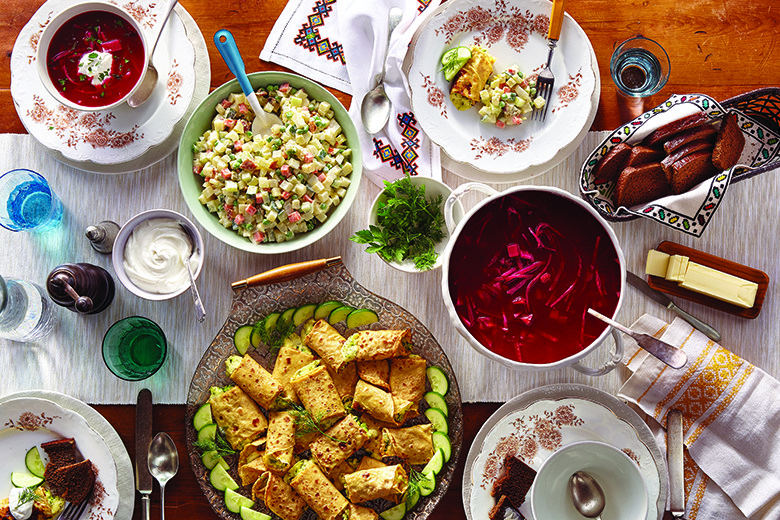
Scents that wafted from the kitchen of my babushka’s (Russian for “grandmother”) flat in Odessa were always extraordinarily delicious. The savory smell of dumplings, pelmeni, borscht and the sweet aroma of traditional stuffed baked buns, or pirozhki, filled the hallway, leading to anticipation of what was inside before the door even opened.
There is a direct link in the brain between scents and memories. In fact, research suggests the sense of smell may be the most powerful sense we have, and even a slight whiff of something familiar can trigger a fond memory from our lives.
When I think of my babushka, it’s always about her mouthwatering food. I can still picture her, wearing a faded apron, laboring for hours in her small, humble kitchen, where she seemed to make magic happen. Freshly kneaded dough and flour would be covering one counter, ripe market vegetables laid out on another, pots and pans bubbling on the stove. If food is an expression of love, then her love was colossal.
Food Origins and Influences
Ukrainian cuisine has been influenced by the local environment, harsh winters and a tradition of peasant cooking. Hardy root vegetables, a variety of grains, garlic, shallots, mustard and fermented dairy, such as kefir and buttermilk, are considered staples. Food preservation techniques such as pickling, drying and salting once were essential in helping Ukrainians endure the long winters, when there were few fresh fruits and vegetables available, and even now remain popular.
Surrounded and invaded by many other nations, Ukraine — including its food — has been influenced by regional customs and neighboring countries. Russian, Belarusian, Polish and Turkish, as well as Hungarian, German and Tatar culinary traditions all left their mark and contributed to the delicious symphony of flavors that is Ukrainian food.
Religion also has played a role in the evolution of Ukrainian cuisine. In different regions of the country, the Orthodox Church, Judaism and Islam all contributed to the uniqueness of the fare, such as the numerous fish stews and pork-free meals. Because of religious fasting requirements and Lent, hearty, healthy vegetarian dishes abound.
Common Flavors and Ingredients
By necessity, Ukrainian cuisine is seasonal. Abundant cucumbers and tomatoes are eaten fresh or pickled, and root vegetables, which can grow in a cold climate and have a long storage life, are used in a variety of traditional dishes.
Beets, cabbage, potatoes, carrots and parsnips are some of the most common vegetables. These often are bought at local farmers markets, called bazaars, and used in dishes such as the hearty salad olivye or the beetroot-based salad vinegret.
Spring and summer in Ukraine mean an abundance of fruits and berries, some of which are wild-picked. Many Ukrainian recipes feature cherries, plums, pears, currants and gooseberries. Varenyky, or pierogi, can be made savory or sweet, with one of the popular flavors being cherry. Since fresh fruit was nearly nonexistent during the winter, many fruits and berries were traditionally canned or made into jams and jellies.
Fresh herbs, particularly dill and parsley, also are plentiful in the summertime. Dill especially is used as an ingredient in or garnish for a vast array of foods. Visitors are sometimes perplexed by the deep-rooted love for dill, but Ukrainian food wouldn’t be Ukrainian without it!
Traditional Dishes and Accompaniments
Borscht is one of the quintessential Ukrainian foods. Many regions have their own versions, which vary according to local ingredients and traditions. With borscht, it’s customary to have a fresh piece (or two) of bread. A key element of Ukrainian cuisine, bread is made from rye or wheat flour and baked in a traditional oven. Even now, bakeries are widespread and a fresh loaf is essential at the table. Sour cream, another element found in many recipes, is a common topping for borscht as well as for dumplings.
Kasha, made of cooked buckwheat, has a nutty flavor and is popular for breakfast or served as an accompaniment to meat. Similar versions are made with other grains. Kasha can be mixed with meat to make filling for Ukrainian stuffed cabbage, which is considered a staple in Ukrainian cuisine.
Game meats, such as rabbit and duck, are a special treat. They are less common and typically are brought home by a relative who hunts. When purchased, game meat can be harder to obtain and more expensive, so it’s usually for a special occasion, such as duck baked with sauerkraut for New Year’s.
Ukraine’s rivers and lakes offer a variety of fish. This, combined with a large portion of the population abstaining from meat during Lent, has resulted in a plethora of Ukrainian fish dishes. One that is quite simple to prepare — and often is part of a traditional celebratory table — is pike fillets baked in sour cream and flavored with carrot, celery and butter-sautéed onion.
Ukrainian food is starting to become better known and embraced around the world — and for good reason. The unique flavor combinations, seasonal ingredients and fresh herbs are ripe for exploration and adaptation. The recipes in this issue — Vegetarian Borscht, Cheesy Crepes with Zucchini and Creamy Potato Salad — are an excellent introduction to some of the delicious cuisine that my family continues to treasure.
Find all the recipes featured in the Food & Nutrition series My Global Table.





